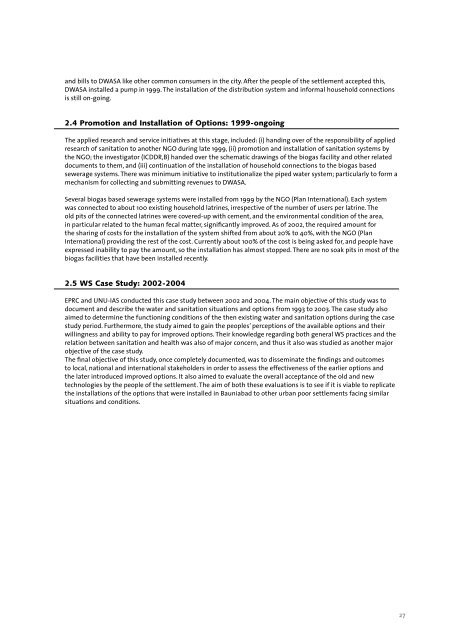Untitled - UNU-IAS - United Nations University
Untitled - UNU-IAS - United Nations University
Untitled - UNU-IAS - United Nations University
Create successful ePaper yourself
Turn your PDF publications into a flip-book with our unique Google optimized e-Paper software.
and bills to DWASA like other common consumers in the city. After the people of the settlement accepted this,<br />
DWASA installed a pump in 1999. The installation of the distribution system and informal household connections<br />
is still on-going.<br />
2.4 Promotion and Installation of Options: 1999-ongoing<br />
The applied research and service initiatives at this stage, included: (i) handing over of the responsibility of applied<br />
research of sanitation to another NGO during late 1999, (ii) promotion and installation of sanitation systems by<br />
the NGO; the investigator (ICDDR,B) handed over the schematic drawings of the biogas facility and other related<br />
documents to them, and (iii) continuation of the installation of household connections to the biogas based<br />
sewerage systems. There was minimum initiative to institutionalize the piped water system; particularly to form a<br />
mechanism for collecting and submitting revenues to DWASA.<br />
Several biogas based sewerage systems were installed from 1999 by the NGO (Plan International). Each system<br />
was connected to about 100 existing household latrines, irrespective of the number of users per latrine. The<br />
old pits of the connected latrines were covered-up with cement, and the environmental condition of the area,<br />
in particular related to the human fecal matter, significantly improved. As of 2002, the required amount for<br />
the sharing of costs for the installation of the system shifted from about 20% to 40%, with the NGO (Plan<br />
International) providing the rest of the cost. Currently about 100% of the cost is being asked for, and people have<br />
expressed inability to pay the amount, so the installation has almost stopped. There are no soak pits in most of the<br />
biogas facilities that have been installed recently.<br />
2.5 WS Case Study: 2002-2004<br />
EPRC and <strong>UNU</strong>-<strong>IAS</strong> conducted this case study between 2002 and 2004. The main objective of this study was to<br />
document and describe the water and sanitation situations and options from 1993 to 2003. The case study also<br />
aimed to determine the functioning conditions of the then existing water and sanitation options during the case<br />
study period. Furthermore, the study aimed to gain the peoples’ perceptions of the available options and their<br />
willingness and ability to pay for improved options. Their knowledge regarding both general WS practices and the<br />
relation between sanitation and health was also of major concern, and thus it also was studied as another major<br />
objective of the case study.<br />
The final objective of this study, once completely documented, was to disseminate the findings and outcomes<br />
to local, national and international stakeholders in order to assess the effectiveness of the earlier options and<br />
the later introduced improved options. It also aimed to evaluate the overall acceptance of the old and new<br />
technologies by the people of the settlement. The aim of both these evaluations is to see if it is viable to replicate<br />
the installations of the options that were installed in Bauniabad to other urban poor settlements facing similar<br />
situations and conditions.<br />
27
















